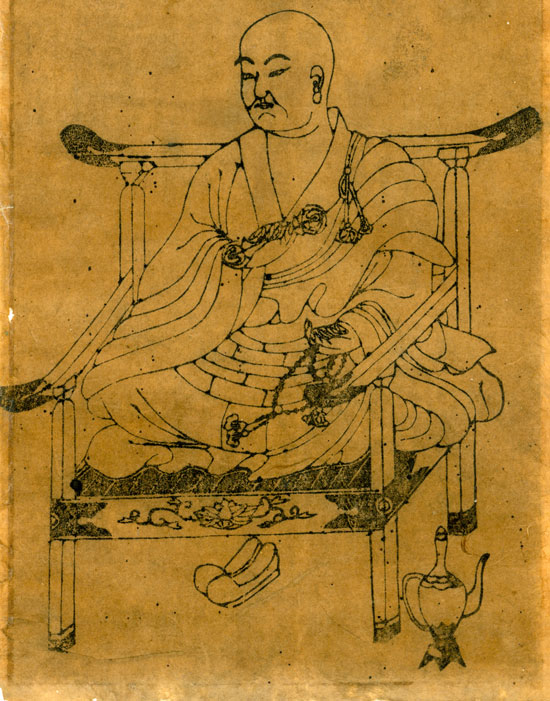mad in pursuit notebook
DISPATCHED FROM THE CROSSROADS
- home >
- favorite themes >
- art & artifacts >
- today's entry
Who Is Kobo-Daishi?

I keep running into this guy. A couple weeks ago I found his image on several Buddhist prints. Another surfaced yesterday (above). Then I found some old ink-blackened woodblocks in Jim’s magic closet — woodblocks used for printing — and there he was again on several of them. (Photo below — challenge to photograph black on black, so it looks silvery.)
At first it looked like this was the actual woodblock that printed the sheet above. But no — tiny differences. But the symbolism surrounding him must be very strong to be repeated so faithfully from version to version.
Jim and I found him immediately in our iconography book: the monk Kukai, who became known as Kobo-Daishi (“Great Teacher of Buddhism”).
Kukai was a religious leader on the order of Martin Luther or John Calvin — establishing a new sect of Buddhism in Japan during the 9th century: Shingon (“mantra”) or Japanese Esoteric Buddhism, which organized many of the concepts of Chinese and Korean esoteric Buddhism into a coherent system.
Buddhism is concerned with the rituals and meditative practices that lead to enlightenment. According to the Shingon doctrine, enlightenment is not a distant, foreign reality that can take aeons to approach but a real possibility within this very life, based on the spiritual potential of every living being, known generally as Buddha-nature. If cultivated, this luminous nature manifests as innate wisdom. With the help of a genuine teacher and through proper training of the body, speech, and mind… we can reclaim and liberate this enlightened capacity for the benefit of ourselves and others. [wikipedia]
Kobo Daishi is still honored today at the monastery he founded on Mount Koya.
In our images he is sits in the lotus pose, with his shoes beneath his chair. He holds a vajraor 3-pointed scepter, symbolizing the “three jewels” of Buddhism (Buddha, teachings, community) and the “three mysteries” of word, thought, and action. It is also a weapon that destroys all evil.
In his left hand is a rosary of 108 beads, used for prayers and mantras. 108 is a sacred number, represent the number of earthly passions and desires that blind and delude us, entrapping us in this world of hurt.
The water jug at his left side is likely associated with the lotus, which symbolizes supreme understanding. It may also represent spiritual cleansing.
So what does it mean to have Kobo Daishi surfacing here, there and everywhere right now? Gosh… some of it has to do with learning — just paying attention to the symbols around me and doing a little research. But maybe the deeper message is a reminder to tune in to my “Buddha-nature.” I will have to think about this some more… (reminding myself that I have spent so much time researching the symbols that I have left no time for reflection).
Helpful references:
Buddhism (Flammarion Iconographic Guides) by Louis Frederic
May 18,2011

